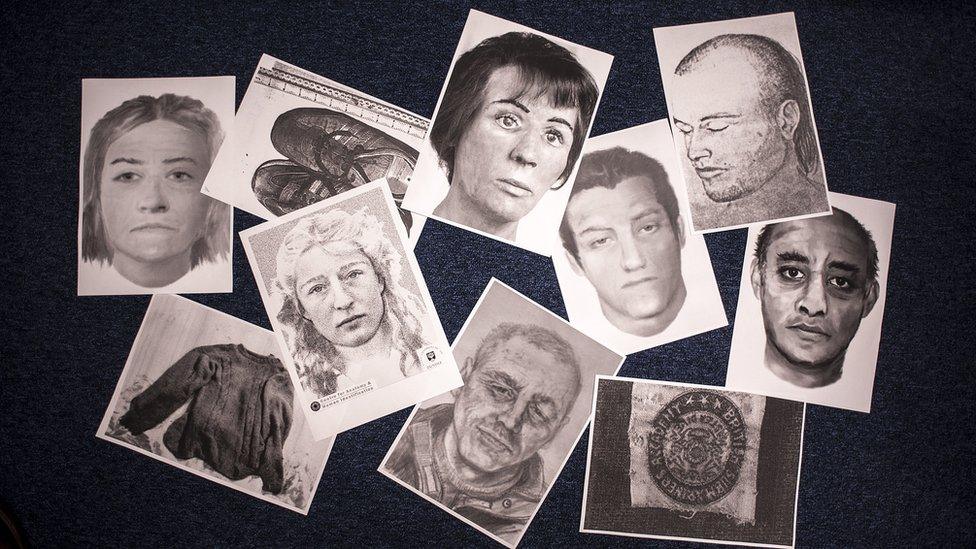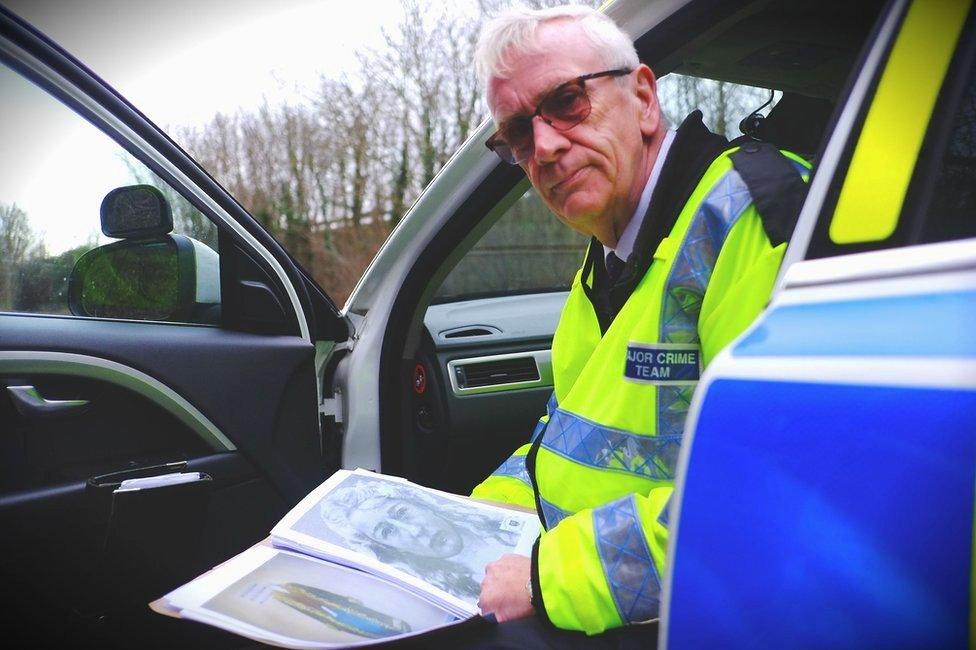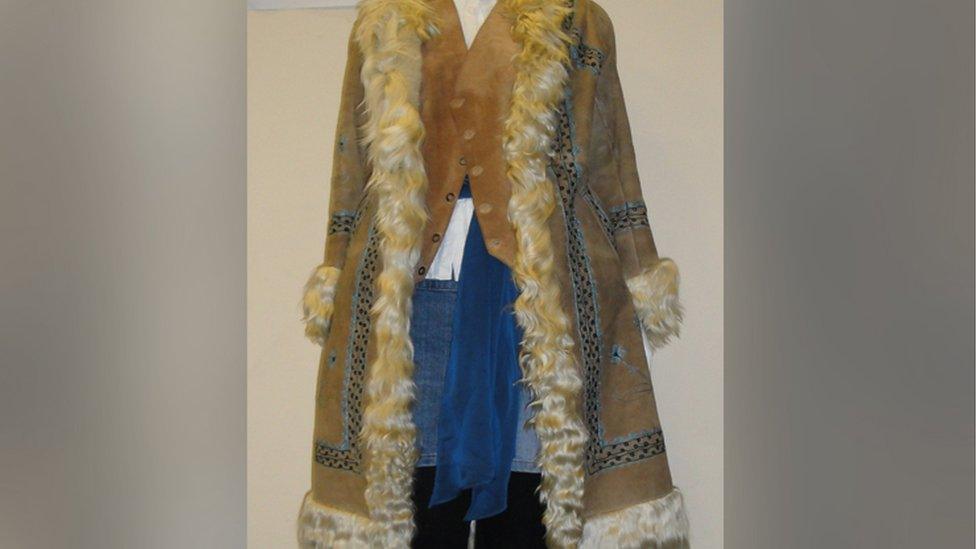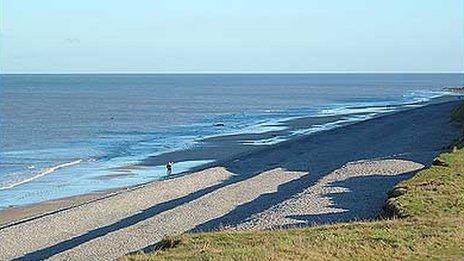England's unclaimed dead and the people trying to give them a name
- Published

Without a name, they are referred to by the clothes they died in or some other distinguishing feature. The lady in the Afghan coat and a woman who may have been a sex worker known as The Duchess are just two of the hundreds of unidentified body cases reported to the National Crime Agency (NCA) each year. Half will be identified and returned to their loved ones. But what happens to the rest?
"I feel I know her, I really do, because I know so much about her," says Det Ch Insp Andy Guy.
He knows what she ate (a lot of seafood), where she came from (probably Denmark), that she was right-handed and had given birth.
What he does not know is her name, or the whereabouts of her head.
The unidentified woman, whose decapitated body was found bound and covered in a dustsheet off a rural path in Cockley Cley, Norfolk 41 years ago, is one of about 1,500 cases registered with the National Crime Agency.
Some are complete bodies, some just body parts.
Sometimes the gender and a rough age of the remains can be determined, other times they cannot.
About 150 unidentified body cases are reported each year.
Most are found by dog walkers, joggers or mushroom foragers, and usually in autumn or late winter, when the foliage has died back.

Det Ch Insp Andy Guy revisits the scene near Cockley Cley where the body of a headless woman was found 41 years ago. She has never been identified
The oldest case on the NCA's database is that of a man, possibly a vagrant in his 40s, whose decomposed body was found in a derelict house in east London.
This year is the 50th anniversary of the discovery.
After London, the areas with the most unidentified people cases are Sussex, with 52, Kent with 31, Essex, with 29 cases and Devon and Cornwall, with 28.
But why would Devon and Cornwall, an area with 1.65m people, have three times as many unidentified cases as somewhere such as West Yorkshire, with its population of 2.2m?
The answer, says Louise Vesely-Shore at the NCA, is the coastline. Bodies not only wash up on the shore, she says, but they also tend to be harder to identify because of the effects of sea water.
"We aim to reconcile 50% of the 120 to 150 cases that come in each year," says Ms Vesely-Shore.
A significant number of unidentified body cases relate either to people who have lost contact with family - and are therefore not reported missing - or foreign nationals who die on UK soil.
Roughly one in 10, says the NCA, is crime related.
Coroners decide what happens to the bodies and although most are buried, some are kept in morgues.

The importance of DNA profiles

The headstone for a stillborn baby - known as Baby Peter - that was paid for by the charity Hana's Gift
The body of a newborn baby was found in a water-filled pit at Weasenham St Peter in Norfolk in June 1988.
For more than a quarter of a century, nobody knew who the baby's mother was or the circumstances of his death.
But in April 2014 the body was exhumed and a DNA profile was taken.
Using that profile, Norfolk Police managed to track down the infant's mother. What emerged was a sad story of a young woman who had hidden her pregnancy from family and friends and who delivered a stillborn baby alone.
Initially arrested on suspicion of infanticide, the woman - whose identity has not been revealed - was later released without charge.
Det Ch Insp Guy said of the case: "One can only feel for the lady involved who has had to carry this enormous burden in secret for all this time."

Ms Vesely-Shore said there were no currently agreed procedures dictating what should happen when a body is found.
She said the NCA "encourages" police and coroners to take samples, fingerprints and DNA, record dental information, and bury in a marked single grave, in case exhumation is needed in future.
In those cases in which the bodies have been cremated, she said, no DNA profile will ever be gleaned. And bodies buried in multiple graves make finding the "right" body "challenging".
Some of these cases, she warns, will now never be solved.
Leading anatomist shows how facial reconstructions are done from human skulls.
"It is sad. And because we have contact with families who are searching, we can see the impact it has on them. Families do not stop searching."
And nor do those officers tasked with trying to solve what are sometimes seemingly impossible cases.
Det Ch Insp Guy, of Norfolk Police's cold case unit, took over the Cockley Cley case in 2007.
Having reviewed the original investigation he brought modern forensic techniques to bear on the case. These revealed she had consumed water found in an area of Scotland and ate a diet heavy in fish and crabs. Armed with her DNA profile, they managed to rule out 555 of the 590 active missing women cases.
One line of inquiry being pursued came from a truck driver about a woman known only as The Duchess.
She is understood to have worked as an escort around the Great Yarmouth docks area in the mid 1970s. Her clients were often truck drivers.
She was in her late 20s or early 30s, came from Denmark and travelled repeatedly across the North Sea between East Anglia and Denmark.
Could the Cockley Cley body have been The Duchess? Norfolk Police hope to find out.

Mick Flavin, of Hertfordshire Police Cold case team, says he still hopes to solve the case of a woman whose body was found on the A1 at Baldock in 1975
Not all breakthroughs yield results.
Hertfordshire Police are continuing to investigate the case of a young woman who suffered horrific injuries on the A1 in February 1975.
Wearing no shoes, she was hitch-hiking for a lift into London and spoke to both a lorry driver and a milkman, taking a yogurt from the rear of the latter's float.
She wore an Afghan-style coat and spoke with a "foreign accent".
A short while later the woman, aged between 23 and 25 and about 5ft 4in tall (1.62m), was run over by a number of vehicles.
In 2010, the force's cold case team garnered her DNA profile and commissioned the University of Dundee to create a post-mortem depiction of how she probably looked.

The Afghan-style coat the woman was wearing at the time of her death in Baldock
The image was seen by a family in Stotfold, Bedfordshire, who thought she could be a young woman who had stayed with them for a few months during the mid 1970s to study English.
Her name, though the spelling is uncertain, was Odile Ludic.
The cold case unit focused in on Ms Ludic and found that she drank locally in Stotfold and had worked for a local company.
They also learned she was most likely from northern Paris. But then the trail went cold. A man believed to have been her former boyfriend is now dead.
"So far it (the suggested name) hasn't really taken us anywhere," admits Mick Flavin, from the force's cold case unit.
"But we do still hope to solve this case."
Inside Out will be broadcast on BBC One in the east of England at 19:30 GMT on Monday and available on iPlayer afterwards
- Published20 November 2013
.jpg)
- Published17 October 2012
